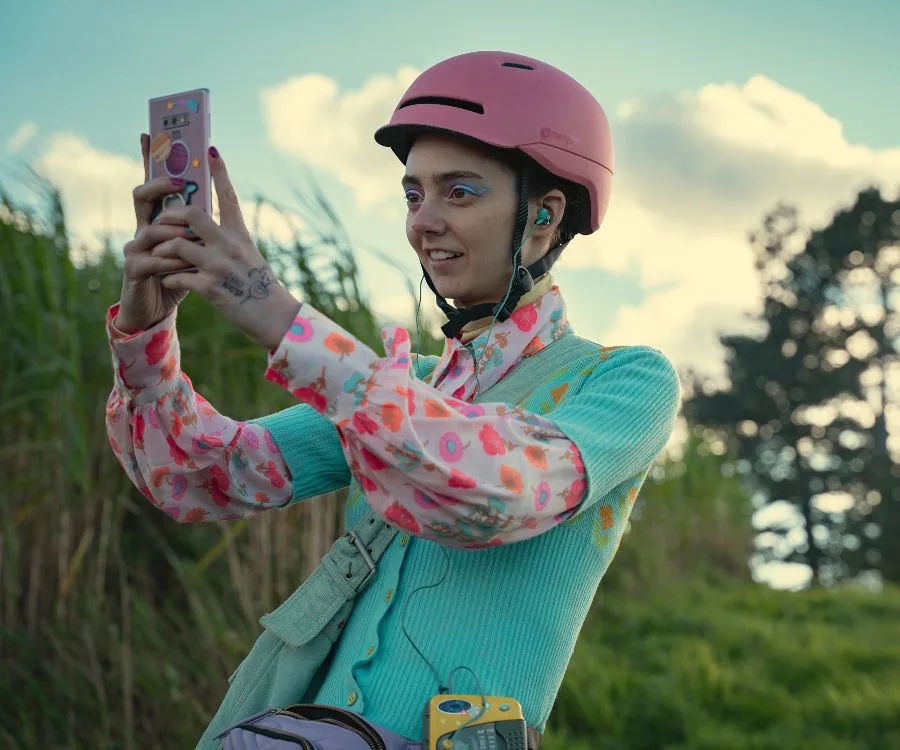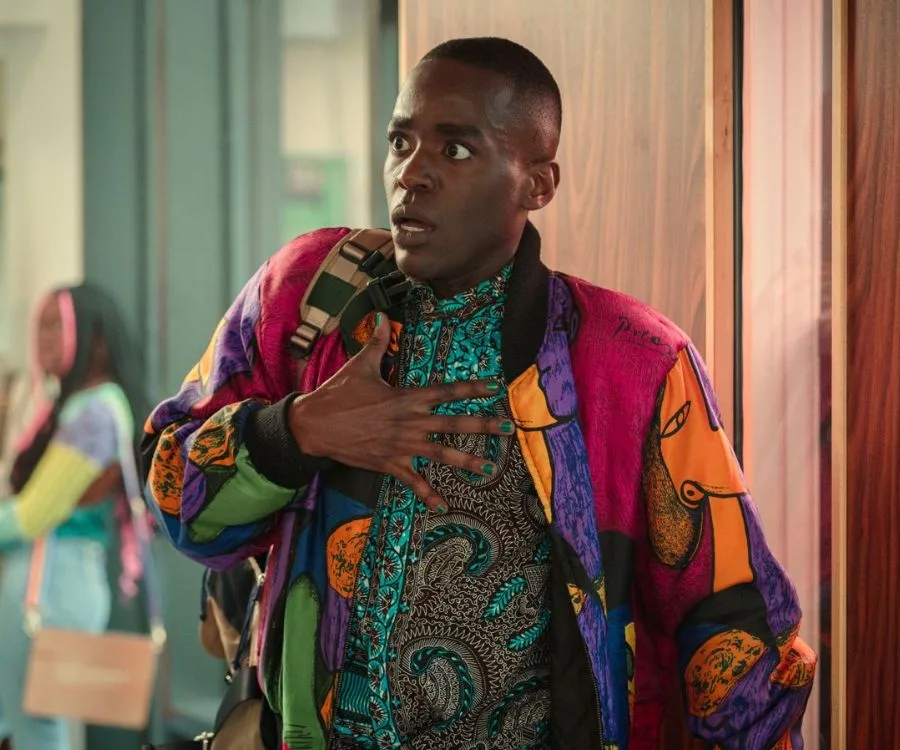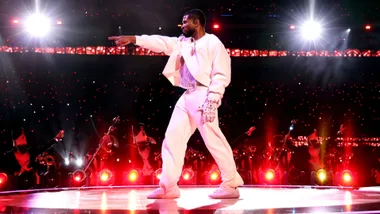Whether you’re in a long-distance relationship or are simply a visual learner/storyteller, sexting and the sending of nudes can be a highly erotic experience. However, it’s not for everyone.
The boundaries around sexting and nudes are topics brought up in the first episode of Netflix’s Sex Education. In the episode, *spoiler alert* Otis dithers about sending Maeve a nude photo in return to the one she sent him. He doesn’t like the photos he takes of himself, and doesn’t feel comfortable sending them. Instead of being honest, he ignores her, creating distance (and a bigger issue) between them.
In the process, Otis realises that he prefers sexting with words, not photos. He ends up being honest with Maeve, and naturally, she’s totally cool to swap the way they communicate long-distance.
It got us (and the many people tuning in for the new series) wondering: what is the correct etiquette around sending nudes? How can we engage in a safe, sexy and consensual way if we want to?
Plus, how should we navigate it if the idea of sending saucy texts makes your skin crawl?
We enlisted the help of not one but two mega Australian sexologists, Bumble’s resident sexologist Chantelle Otten and Lovehoney’s sex and relationships expert Cam Fraser. Here, they decode and demystify the nudes and sexting experience. There’s no need to feel like Otis!

Is It Ok To Sext Or Send A Nude?
It’s important to establish that good sexting practice is not here to ‘yuck yums’. There are definitely people who will get a lot out of sexting and sending nudes and that’s perfectly acceptable, even fun. However, it’s also important to be aware that it’s not for everyone.
“It can definitely be fun and pleasurable to send nudes to a consenting person. Some recent research found that there are several aspects of sexting and sending sexual digital imagery that can be enjoyable and arousing, from the initial creation of the image to the vulnerability of sending it to the anticipation of receiving a message in return,” explains Fraser.
He explains that this is always subject to consent and agreements made within the relationship. It’s also important that everyone participating is of age.
For Otten, the issue of consent is vital in this sexual practice.
“It’s important to ask for digital consent before engaging in virtual intimacy over text, audio or video. Consent is when someone gives you an enthusiastic “yes” to an intimate or sexual request,” she says.
“If it’s a heck yes, then it can be a fun intimate exchange. Consent both in real life and online is crucial.”
She adds that dating apps, such as Bumble, do have rules around the sending and receiving of nudes. They cannot be sent without consent, or your profile will be banned.
“This might be sending unsolicited lewd imagery, sending sexual messages, trying to have virtual sex, or even sending sexually suggestive emojis or gifs without the consent of the other person, as it could make them feel uncomfortable, triggered, or violated.”
What Is The Best Way To Navigate Sexting And Nudes?

Fraser says that it’s important to ask the person you’re wanting to sext with if they’re comfortable engaging in it.
“If they do consent, you might like to have an agreement with them that they don’t show it to anyone else. When it comes to creation of your own sexual digital imagery, you may consider not showing your face or other identifying features, only showing as much as you feel comfortable with,” he says.
Otten is keen to make sure that people know that asking for consent isn’t awkward, it can actually be pretty arousing.
“The notion that asking someone for permission to engage with them intimately (whether in person or virtually) is unsexy just isn’t true. Your matches will appreciate the fact that you asked first,” she says.
“The best way to do it is to be clear and specific about what you are asking for and your boundaries. Keep in mind that asking for consent is necessary even if you’ve engaged with the person intimately before. Also, be open to rejection as everyone has a right to decide their comfort level with any kind of intimacy.”
She suggests some thought starters, including:
- “I’d love to show you exactly how I feel. Can I send you a nude photo?”
- “I feel like there’s something between us here. Would you be interested in sexting with me?”
- “Would you want to have video sex with me? No pressure either way.”
When Should You Hold Fire On Sexting And Nudes?

Naturally, you should never send a nude or sext to someone who hasn’t given enthusiastic consent.
Trust is also an essential factor. Otten explains, “Trust is important before engaging in sexting or sending a nude and it’s crucial to be aware of the risks inherent in virtual intimacy, especially where photos or videos are involved.”
In terms of specific situations when you should hit pause?
- Early On In The Relationship
While Otten knows that the chemistry can feel ‘electric’ early on, allowing trust to build in your relationship is key before diving into digital intimacy. She adds, “If you ever find yourself feeling pressured to send explicit material, it’s a clear sign to put things on hold. Consent should be freely given, and your comfort should never be compromised.”
- If You’re Not Sure You Can Trust Them
While you might feel sexually attracted to your partner, you want to feel secure that your digital interactions will be kept in trust.
“Trust is a two-way street, and both parties should feel secure in their digital interactions,” she says.
- You’re Not Tech Smart
If you’re not sure of the best way to send your nudes and keep them private, it might be worth holding off until you’ve researched.
“Invest some time in learning about secure messaging apps to protect yourself, such as WhatsApp’s 1 second photo. You cannot screenshot a one second photo,” she says.
- If You Don’t Have Clear Guidelines
“If you’re navigating non-monogamous or open relationships, be sure to have transparent conversations about boundaries and expectations before sexting new partners,’ she says.
“In the end, as thrilling as digital intimacy can be, never lose sight of trust, communication, and consent. If doubts or discomforts arise, remember that it’s absolutely okay to take a step back and have an open, honest conversation about your boundaries and expectations.”
How To Say No To Sexting Or Receiving/Sending A Nude

Say you’re really loving someone’s vibe and they suggest a sexting situation or a nude photo exchange, what do you say if you’re not feeling it but you’re still keen on them?
For Fraser, the first thing is to understand why you’re feeling like it’s not for you.
“Why is it a boundary for you? Is it because it is not something that arouses you in general? Is it because you’re worried about being caught? Is it because you don’t trust this person? Is it because you’re not at that stage of the relationship yet? Or it could be another reason entirely. Understanding why you are or aren’t comfortable with something can be helpful when asserting your boundaries. It helps you be clear and demonstrates that it is about you, not them,” he says.
When it comes to asserting that boundary, Otten says it can be communicated easily over text.
“You could text something like: “Hey, I’m not really into sexting,” or “I would rather you not send me messages like that,” and then move the conversation in another direction, like what flavour Smiths chip reigns supreme? After all, you can be intimate without sexting.”
Apps these days do have inbuilt tools that can help if you’re concerned about receiving unsolicited photos. Bumble offers something called ‘Private Detector’, which uses A.I. to automatically blur potential nudes sent on Bumble. You can choose to view or block the image depending on what you’re comfortable with.
The Ultimate Guide To Sexting And Nude Rules, According To Chantelle Otten

- Ask for Digital Consent
Just like in-person interactions, digital intimacy requires clear and unequivocal consent. Before sending or requesting explicit content, make sure both parties are comfortable and agreeable.
- Keep It Private
Always ensure that your messaging platform is secure and private. Use apps with end-to-end encryption and steer clear of sharing explicit content over social media platforms, which may be less secure.
- Communicate Clearly
Clear and open communication is key. Not just for what you’re comfortable doing, but also for what your partner is comfortable receiving. Discuss your boundaries beforehand to ensure both parties are on the same page.
- No Screenshots or Sharing
Unless explicit permission is granted, never share the content with others. This is a breach of trust and could also be illegal in some jurisdictions.
- Assess the Situation
Whether you’re in a long-term relationship or it’s a newer fling, always gauge the level of trust and emotional connection before diving into digital intimacy. Rushing can lead to regrets or misunderstandings later on.
- Check-in Regularly
As relationships evolve, so do boundaries and comfort levels. Make it a point to regularly check in with your partner about what is and isn’t acceptable in your digital interactions.
- Be Mindful of the Legal Age
Ensure that both parties are above the legal age of consent. No brainer!
- Don’t Forget the Aftercare
After engaging in digital intimacy, take a moment to connect emotionally. This can be a simple message or a more in-depth conversation, but it’s an important step to ensure everyone feels respected and cared for.
Remember, the best digital interactions, like the best in-person ones, are built on a foundation of trust, communication, and mutual respect. If ever in doubt, don’t hesitate to pause and have an open dialogue about your boundaries and expectations.










